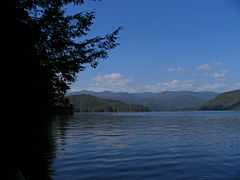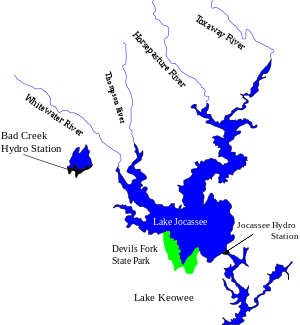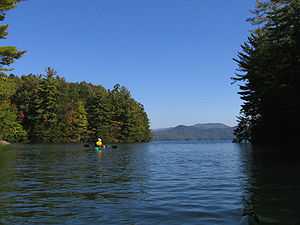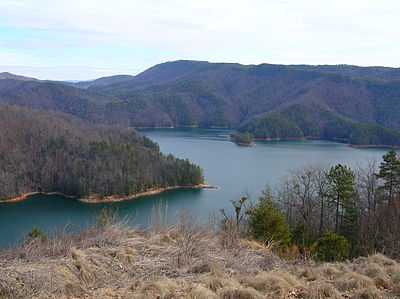Lake Jocassee
| Lake Jocassee | |
|---|---|
 | |
| Location | Oconee / Pickens counties, South Carolina, USA |
| Coordinates | 34°57′36″N 82°55′10″W / 34.96000°N 82.91944°WCoordinates: 34°57′36″N 82°55′10″W / 34.96000°N 82.91944°W |
| Type | Reservoir |
| Primary inflows | Horsepasture, Toxaway, Whitewater, Thompson Rivers |
| Primary outflows | Keowee River |
| Basin countries | United States |
| Surface area | 7,500 acres (30 km2) |
| Average depth | 158 ft (48 m) |
| Max. depth | 350 ft (110 m) |
| Shore length1 | 75 mi (121 km) |
| Surface elevation | 1,100 ft (340 m) |
| Frozen | No |
| Islands | Dozen small islets |
| Settlements | Clemson, Pickens, Salem, and Seneca |
| 1 Shore length is not a well-defined measure. | |
Lake Jocassee is a 7,500-acre (30 km2), 300-foot (91 m) deep reservoir located in northwest South Carolina created by the state in partnership with Duke Power in 1973.[1] The lake is commonly known for the clean and cold Appalachian mountain rivers that feed the lake to keep its waters cool and clear year-round. The Jocassee Dam, which forms the lake, is 385 feet (117 m) high and 1,750 feet (530 m) long. The lake is home to Devils Fork State Park.
Although most manmade structures were demolished prior to the creation of the lake, divers recently discovered the remains of a lodge which was left intact until the lake rose and now sits below 300 feet of water; a hilltop graveyard with headstones also remains more than 130 feet under the water.[2] The cemetery was one of the scenes used in the filming of the 1972 thriller, Deliverance, starring Burt Reynolds and Jon Voight.
Hydrology

A confluence of four rivers supplies Lake Jocassee's water. The farthest west of the rivers, the Whitewater River, flows southeast until it meets the northwest corner of Lake Jocassee. The Thompson River flows due south until it too reaches the lake in the northwest corner. The Horsepasture River feeds the lake from the northeast corner, along with the Toxaway River, which is directly east of the Horsepasture River.
The Jocassee Hydro Station, located in the southeast corner of Lake Jocassee, separates it from the beginning of Lake Keowee, also known as the Keowee River. Lake Keowee's furthest extent to the south brings it close to the city of Seneca, with the old mill town of Newry actually on it. Unlike Lake Jocassee, Keowee is heavily settled, primarily because most of the land,but not all, adjacent to Lake Jocassee is owned by Duke Power and the State of South Carolina.
Natural history

A rare wildflower, the Oconee Bell (Shortia galacifolia), native to only a few counties in the Blue Ridge area, was discovered in the area in 1788 by French botanist André Michaux. The creation of Lake Jocassee is said to have caused the destruction of the heart of the species' range.[3] More recently, biologists have documented the occurrence of a number of rare, threatened and endangered species. The Eastatoee Gorge Heritage Preserve was transferred from Duke Power Company to the South Carolina Department of Natural Resources in 1979 due to the extremely diverse flora occurring there.
Wildlife management efforts in the Jocassee Gorges area began as early as the 1930s when the Chief Game Warden managed the stocking of trout from the Cleveland State Fish Hatchery, Table Rock State Hatchery, and the Walhalla National Fish Hatchery. This led to the investigation and improvement of fish populations in the area. People hiking, hunting, fishing, or nature watching benefit from the fish stocking and law enforcement of the Game Management Program (now WMA).[1]
History
The name Jocassee comes from the legend of a Cherokee maiden. An Oconee tribe, the "Brown Vipers" led by Chief Attakulla, inhabited the west side of the Whitewater river, while a rival tribe, "The Green Birds", lived on the east. Legend says that a young Green Bird warrior,
The Jocassee Gorges area was once home to the part of the Cherokee Nation; it now lies 300 feet (91 m) beneath the surface of the lake, near the Toxaway River. Nearby Keowee Town was a major hub in the Cherokee Path that connected Cherokee towns and villages throughout the area. Early 18th century traders delivered as many as 200,000 deerskins annually to Charleston, South Carolina and local Indians became well supplied with European firearms, ammunition, tools and clothing as a result. However, mounting discord between Europeans and Cherokees led to war in 1759. In 1785, General Andrew Pickens hosted a large gathering of Indian chiefs leading to a treaty that gave all of the Jocassee gorges area, with the exception of northern Oconee County, to the United States; the Oconee mountains were not ceded until 1815. European settlers, mostly of Scottish and Irish descent, came from Virginia and Pennsylvania as well as from Charleston. Land grants in the Jocassee area go back to 1791.
Lake Jocassee was one of the filming locations for the 2012 movie, The Hunger Games.
Fishing
Lake Jocassee holds state records for 5 species of fish, including three in the sunfish family (Centrarchidae). In 2001 a 5 lb 2.5 oz (2.34 kg) Redeye bass and a 9 lb 7 oz (4.3 kg) Smallmouth bass were caught. A 8 lb 2 oz (3.7 kg) Spotted bass was caught in 1996. The last two came from the salmon family (Salmonidae). A 17 lb 9.5 oz (7.98 kg) Brown trout was caught in 1987 and a 11 lb 5 oz (5.1 kg) Rainbow trout was caught in 1993.[4]
Economy
The Jocassee Hydro Station, owned by Duke Power, in between Lake Jocassee and Lake Keowee, is a 610 megawatt pumped storage facility. Also, just off the Whitewater River, Bad Creek Hydroelectric Station is a 1,065 megawatt pumped-storage facility that started generating electricity in 1991 and is also owned by Duke Power.[5] Both facilities provide jobs for the surrounding area.
Nearby cities and towns
- Salem, South Carolina- pop. 126
See also
References
- ↑ 1.0 1.1 1.2 "Jocassee History". Retrieved 2007-10-29.
- ↑ CNN.com: "Divers find hotel 300 ft. down", February 25, 2009; accessed February 25, 2009.
- ↑ Porcher, D.W. & Rayner, D.A. (2001). A Guide to the Wildflowers of South Carolina. Columbia: University of South Carolina Press. ISBN 1-57003-438-9.
- ↑ Freshwater Fish Records for South Carolina
- ↑ "Jocassee- Duke Energy". Retrieved 2007-10-29.